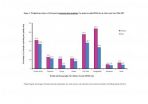(Press-News.org) Most of the world's population will be subject to degraded air quality in 2050 if man-made emissions continue as usual. In this 'business-as-usual' scenario, the average world citizen 40 years from now will experience similar air pollution to that of today's average East Asian citizen. These conclusions are those of a study published today in Atmospheric Chemistry and Physics, an Open Access journal of the European Geosciences Union (EGU).
Air pollution is a major health risk that may worsen with increasing industrial activity. At present, urban outdoor air pollution causes 1.3 million estimated deaths per year worldwide, according to the World Health Organisation [1].
"Strong actions and further effective legislation are essential to avoid the drastic deterioration of air quality, which can have severe effects on human health," concludes the team of scientists, led by Andrea Pozzer of the Abdus Salam International Centre for Theoretical Physics in Italy (now at the Max Planck Institute of Chemistry in Germany), in the new paper.
The researchers studied the impact of man-made emissions on air quality, assuming past emission trends continue and no additional climate change and air pollution reduction measures (beyond what is in place since 2005) are implemented. They point out that, while pessimistic, the global emissions trends indicate such continuation.
"At present the post-Kyoto climate negotiations are progressing slowly, and it is unclear how air quality policies will develop globally," explains co-author Greet Janssens-Maenhout of the European Commission Joint Research Centre in Italy. "In regions with economic growth, it might be less effective to implement emission-reduction measures due to strong growth in activities in particular sectors; in countries suffering from the economic downturn, implementing expensive air-quality measures could prove difficult in coming years," she adds.
"We show that further legislation to control and reduce man-made emissions is needed, in particular for eastern China and northern India, to avoid hot-spots of elevated air pollution," says Pozzer. Combined with the fact that these are regions of high population density, elevated air pollution here would mean that air quality would worsen significantly for the average world citizen in 2050.
Air pollution would also increase in Europe and North America, but to a much lesser extent than in Asia, due to the effect of mitigation policies that have been in place for over two decades.
Pozzer and his colleagues estimated air quality in 2005, 2010, 2025 and 2050 using an atmospheric chemistry model. "The model uses basic mathematical formulation to predict the meteorology and the chemical composition of the atmosphere," Pozzer explains. "In practice, it is a software used to forecast – or hindcast, for past years – the status of the atmosphere at specific times."
The results show that in 2025 and 2050, under the business-as-usual scenario studied, East Asia will be exposed to high levels of pollutants, such as nitrogen dioxide, sulphur dioxide and fine particulate matter (PM2.5) [2]. Northern India and the Arabian Gulf region, on the other hand, will suffer a marked increase in ozone levels.
The analysis now published is the first to include all five major air pollutants know to negatively impact human health: PM2.5, nitrogen dioxide, sulphur dioxide, ozone, and carbon monoxide. The scientists considered pollutants released through human activity, as well as those occurring naturally such as desert dust, sea spray, or volcanic emissions.
Taking all pollutants into account, eastern China, northern India, the Middle East, and North Africa are projected to have the world's poorest air quality in the future. In the latter locations this is due to a combination of natural desert dust and man-induced ozone. The effect of anthropogenic pollution emissions are predicted to be most harmful in East and South Asia, where air pollution is projected to triple compared to current levels.
The study aimed to compare the influence of man-made emissions on air quality in different regions, and show how no-further legislation to reduce emissions can result in drastic deterioration of air quality worldwide compared to the present day situation.
### [1] World Health Organisation (WHO) 'Air quality and health' fact sheet (September 2011) http://www.who.int/mediacentre/factsheets/fs313/en/index.html
[2] PM2.5 refers to pollutant particles less than 2.5 micrometers in aerodynamic size, or about a quarter of the size of a cloud droplet. According to the WHO, "PM affects more people than any other pollutant." PM2.5 is more dangerous than particulate matter of larger size because these particles can reach the smallest of airways and interfere with gas exchange in the lungs. (Source: http://www.who.int/mediacentre/factsheets/fs313/en/index.html)
Cut emissions further or face risks of high air pollution, study shows
2012-08-01
ELSE PRESS RELEASES FROM THIS DATE:
Mayo Clinic completes first genome-wide analysis of peripheral T-cell lymphomas
2012-08-01
ROCHESTER, Minn.-- Researchers at Mayo Clinic have completed the world's first genome-wide sequencing analysis of peripheral T-cell lymphomas, unlocking the genetic secrets of this poorly understood and highly aggressive cancer of the immune system.
Andrew Feldman, M.D., a Mayo Clinic pathologist and Damon Runyon Clinical Investigator, and a team of researchers affiliated with Mayo's Center for Individualized Medicine and Mayo Clinic Cancer Center, found 13 genomic abnormalities that were seen in multiple peripheral T-cell lymphomas. Of particular interest, five of these ...
Scientists discover molecular link between circadian clock disturbances and inflammatory diseases
2012-08-01
LA JOLLA, CA ---- Scientists have known for some time that throwing off the body's circadian rhythm can negatively affect body chemistry. In fact, workers whose sleep-wake cycles are disrupted by night shifts are more susceptible to chronic inflammatory diseases such as diabetes, obesity and cancer.
Researchers at the Salk Institute for Biological Studies have now found a possible molecular link between circadian rhythm disturbances and an increased inflammatory response. In a study published July 9 in Proceedings of the National Academy of Sciences, the Salk team found ...
Fruit flies on methamphetamine die largely as a result of anorexia
2012-08-01
CHAMPAIGN, Ill. — A new study finds that fruit flies exposed to methamphetamine drastically reduce their food intake and increase their physical activity, just as humans do. The study, which tracked metabolic and behavioral changes in fruit flies on meth, indicates that starvation is a primary driver of methamphetamine-related death in the insects.
The new findings are described in The Journal of Toxicological Sciences.
The abuse of methamphetamine can have significant harmful side effects in humans. It burdens the body with toxic metabolic byproducts and weakens the ...
AAO-sponsored research shows cataract surgery can reduce hip fracture risk
2012-08-01
SAN FRANCISCO – August 1, 2012 – A major study of Medicare beneficiaries shows that the risk of hip fractures was significantly reduced in patients who had had cataract surgery, compared to patients who did not undergo the procedure. Published in the August edition of the Journal of the American Medical Association (JAMA) the researchers believe their study is the first to demonstrate that cataract surgery reduces the rate of fractures in older patients with vision loss. This suggests that cataract surgery could be an effective intervention to help prevent fractures and ...
New study suggests clinicians overlook alcohol problems if patients are not intoxicated
2012-08-01
Medical staff struggle to spot problem drinking in their patients unless they are already intoxicated, according to research by the University of Leicester.
The work led by Dr Alex J Mitchell, consultant at Leicestershire Partnership NHS Trust and honorary senior lecturer at the University, reveals that clinical staff often overlook alcohol problems in their patients when they do not present intoxicated.
In a new study published in the British Journal of Psychiatry today (1 August) involving 20,000 patients assessed for alcohol problems by medical staff, all clinicians ...
DMP module on heart failure: Current guidelines indicate some need for revision
2012-08-01
The German Institute for Quality and Efficiency in Health Care (IQWiG) published the results of a literature search for evidence-based clinical practice guidelines on the treatment of people with heart failure. The aim of the report is to identify those recommendations from current guidelines of high methodological quality that may be relevant for the planned revision of the module "heart failure" in the disease management programme (DMP) for coronary heart disease (CHD). According to the results of the report, there is no compelling need for revision of any part of the ...
Better student preparation needed for university maths
2012-08-01
Moving from sixth form, or college, into higher education (HE) can be a challenge for many students, especially those who start mathematically demanding courses. Life prior to university focuses on achieving maximum examination success to be sure of a place. Faced with this pressure, school and college maths courses pay little attention to preparing students to use maths in other areas of study according to a project funded by the Economic and Social Research Council (ESRC).
A student's ability to apply mathematical reasoning is critical to their success, especially in ...
Strangers on a bus: Study reveals lengths commuters go to avoid each other
2012-08-01
You're on the bus, and one of the only free seats is next to you. How, and why, do you stop another passenger sitting there? New research reveals the tactics commuters use to avoid each other, a practice the paper, published in Symbolic Interaction describes as 'nonsocial transient behavior.'
The study was carried out by Esther Kim, from Yale University, who chalked up thousands of miles of bus travel to examine the unspoken rules and behaviors of commuters.
Over three years Kim took coach trips across the United States. Kim's first trip, between Connecticut and New ...
Global 'sleeplessness epidemic' affects an estimated 150 million in developing world
2012-08-01
Levels of sleep problems in the developing world are approaching those seen in developed nations, linked to an increase in problems like depression and anxiety.
According to the first ever pan-African and Asian analysis of sleep problems, led by Warwick Medical School at the University of Warwick, an estimated 150 million adults are suffering from sleep-related problems across the developing world.
The results are published in a study in the journal Sleep.
Warwick Medical School researchers have found a rate of 16.6 per cent of the population reporting insomnia and ...
Too cool to follow the law
2012-08-01
So-called glass-formers are a class of highly viscous liquid materials that have the consistency of honey and turn into brittle glass once cooled to sufficiently low temperatures. Zhen Chen and his colleagues from Arizona State University, USA, have elucidated the behaviour of these materials as they are on the verge of turning into glass in an article about to be published in EPJ E¹.
Although scientists do not yet thoroughly understand their behaviour when approaching the glassy state, this new study, which relies on an additional type of dynamic measurements, clearly ...



